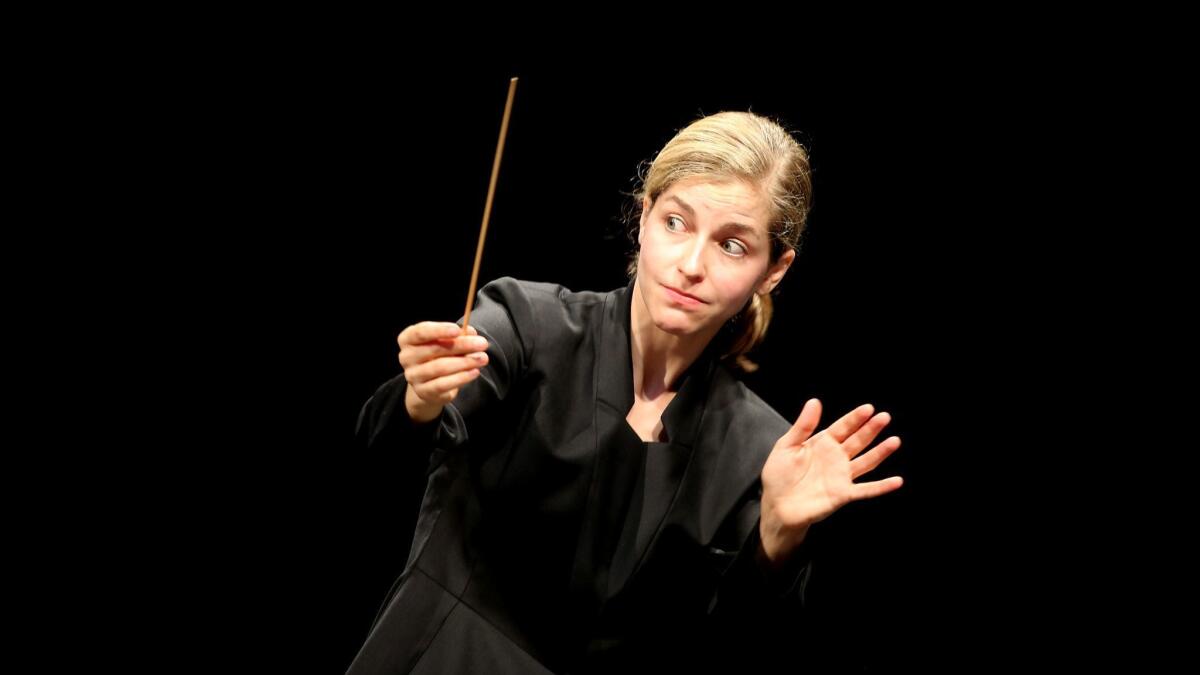Review: Karina Canellakis, back in L.A. with a hire-wire act

- Share via
Karina Canellakis will not be the next music director of the Los Angeles Chamber Orchestra. When she made her impressive debut at the beginning of 2015, she seemed a likely candidate. But it was apparently love at first downbeat when Spanish conductor Jaime Martín made his debut with the ensemble last fall. He was appointed in February before Canellakis had a chance to return.
Of course, the young American violinist and conductor, who was once more sensational Sunday night at UCLA’s Royce Hall, may have been holding out all along for bigger orchestral fish to fry. She is rumored to be a leading candidate to succeed Jaap van Zweden at the Dallas Symphony.
Three years ago, she was an unknown. By last year, she was conducting the Los Angeles Philharmonic at the Hollywood Bowl. On her plate the next two months are the Indianapolis Symphony, Seattle Symphony and Orchestre de Paris. She’ll once again conduct the BBC Symphony at the Proms in July and the L.A. Phil at the Bowl in September. If not Dallas, she’ll inevitably wind up somewhere important.
Canellakis’ first LACO program was a little out of the ordinary: She was soloist in a Vivaldi concerto, knocked John Adams’ “Shaker Loops” out of the park but may have tried a little too hard to impress in Schubert’s modest Fifth Symphony. This time she was both more conventional and gutsier, with Beethoven’s Second Symphony; Mozart’s late Piano Concerto No. 24, with David Fray as soloist; and the U.S. premiere of Dai Fujikura’s “Secret Forest.”
“Secret Forest” is a funny (odd) piece, and Fujikura is, here, a funny (ha-ha) composer. Born in Osaka in 1977 and living now in London, he told the audience that he has always been a big city guy. Like most Japanese, he fancies the idea of forests, but he also rebels against nature, and he’s not so sure the forest likes him. The few times he’s visited one, he’s had allergy attacks. Birds sing (“if you can call that singing!” he once wrote in a program note) pitches he finds annoying. Don’t get him started on insects. He said he does like the sound of rain but does not like getting wet.
This then is Fujikura’s fantasy forest. The strings are seated onstage, while the wind and brass instruments are scattered along the sides and back of the auditorium. A solo bassoon stands in a center aisle, representing the composer in the forest. The strings alternate between sharply accented tremolos — the scrunching, one imagines, of feet on dry leaves — and more reflective sounds.
The winds could be the mysterious creatures in the distance and best kept there. The bassoon part, which was engagingly played by Kenneth Munday, is the lonely musing human, out of his element. Yes, it rains, when the wind players pick up rain sticks to rattle. Everyone stays dry.
Royce is not an ideal hall for surround sound. Muted acoustics made Fujikura’s forest seem a little too secret, barely threatening, a landscaping effort rather outright deforestation. Still it is a fascinating piece and a reminder that we hear far too little of him. In the U.S. his only real champion is International Contemporary Ensemble, of which Canellakis was once a regular guest.
It was hard to know what to make of Mozart’s operatically serious C-Minor Concerto. Canellakis’ tempos were sprightly. She gave every phrase character. The orchestra sounded fresh as spring.
The French pianist, however, played with a great heaviness. Fray frowned. He rarely looked up from the keyboard, and when he did it was to frown at something else. His tone was full-bodied and resonant, in contrast to the lighter textures Canellakis got from the orchestra. She looked toward Haydn; he toward Beethoven. Was this a soloist in the wrong orchestral forest and needing his own secret Mozart?
But appearances can deceive. The performance seemed to work, especially in a beautifully reflective slow movement. When it was over, Fray was suddenly all smiles to the orchestra and to Canellakis. They walked off as though best friends.
When it came to Beethoven, Canellakis sprung the Second Symphony on the audience. She is a slender, athletic woman who conducts like a wound-up spring. She lives for sforzandi, those sudden instances of emphasis. That can start to seem like mannerism, but exaggerations in young Beethoven served instead to emphasize newness, while her rhythmic propulsion swept away all that came before.
Canellakis’ high-wire act was a dare. The players were kept on the edge of their seats. Something could have derailed it at any moment. Nothing did. It was great.
More to Read
The biggest entertainment stories
Get our big stories about Hollywood, film, television, music, arts, culture and more right in your inbox as soon as they publish.
You may occasionally receive promotional content from the Los Angeles Times.











